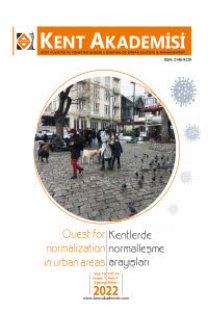Kentsel Açık Alanların Değerlendirilmesi: Karaköy Örneği
Kamusal Alan, Kamusal Yaşam, Yer Kimliği, Karaköy
Evaluation Of Place Identity In Urban Open Space: Example Of Karaköy
Punlic space, Public life, Place identity, Karaköy,
___
- AKIN, N. (2011), Galata ve Pera, Literatür Yayıncılık, İstanbul.
- ASLAN, Ş. (2011). Birleştiren ve Ayrıştıran İşlevleriyle İstanbul’da Boğaz Köprüler’nin Toplumsal Dili. İstanbul Üniversitesi Siyasal Bilgiler Fakültesi Dergisi , 0 (44), Erişim: https://dergipark.org.tr/tr/pub/iusiyasal/issue/594/5981.
- APPLEYARD D., GERSON S.M., LINTELL M. (1981). Livable Streets, University of California Press.
- BOURDIEU, P. (1984). Distinction: A Social Critique of the Judgment of Taste, Routledge and Kegan Paul, London.
- FREELY, J. (2005). John Freely İstanbul'. Watson H. (Der.), Ofset Yapımevi, 178-180.
- GEHL, J. (1987). Life Between Buildings: Using Public Space Washington-Covelo-London: Island Press.
- GEHL, J. ve SVARRE, B. (2013). How To Study Public Life? Washington, DC: Island Press.
- GEHL ARCHITECTS. Urban Quality Consultants. Gl. Kongevej 1, 4.tv . 1610 Copenhagen V. Denmark. Erişim:https://gehlpeople.com/wp-content/uploads/2020/03/TWELVE-QUALITY-CRITERIA.pdf , 18.02.2020.
- HAUGE, C. (2004). Planning and Place Identity. Hague, C. ve Jenkins, P. (Der.), Place Identity, Participation and Planning. London: Routledge, 3-17.
- JACOBS, J. (1961). The Death and Life of Great American Cities. New York: Random House.
- HÜRRİYET (2 Aralık 2015). Karaköy Balık Pazarı Yeniden Açıldı. Hürriyet Gazetesi. Erişim: 17 Kasım 2019, http://www.hurriyet.com.tr/gundem/karakoy-balik-pazari-yeniden-acildi-40009411.
- LEFEBVRE, H. (1971). Everyday Life in the Modern World, (S. Rabinovitch, Çev.). NY: Harper & Row Publishers.
- LEFEBVRE, H. (1991). The Production of Space. Blackwell, Cambridge.
- LUTZONI, L. (2016). ‘In-formalised urban space design. Rethinking the relationship between formal and informal’, City, Territory and Architecture ,volume 3, Article number: 20.
- LILJA, E. (1995). İnsan vizyonu ve toplum planlaması. Nordic Topluluk Planlama Enstitüsü, Rapor 1995: 1, Stockholm.
- LYNCH, K. (1960). The Image of the City. MIT Press, Cambridge.
- Projects for Public Spaces. (PPS) (2008). ‘JAN GEHL’. https://www.pps.org/article/jgehl [2019-11-27].
- SENNETT, R. (1999). Gözün Vicdanı: Kentin Tasarımı ve Toplumsal Yaşam. Ayrıntı Yayınları, İstanbul.
- SIMMEL, G. (1950). Metropolis and the Mental Life. Free Press, New York.
- SUHER, H., OCAKÇI, M., KARABAY AYATAÇ, H., ERTEKIN, Ö. (2004) An Indicator of Sustainable Development: Urban Identity, ITÜ AZ Dergisi (2004-2), Vol. 1, No 2, 26-42: s 27.
- TEKELİ, İ. (1996). Modernleşme Sürecinde Osmanlı Kentleri; Dumont, P. ve Georgeon, F. (Der.). Tarih Vakfı Yurt Yayınları, İstanbul.
- ISSN: 2146-9229
- Yayın Aralığı: Yılda 4 Sayı
- Başlangıç: 2008
- Yayıncı: Karadeniz Yazarlar ve Şairler Derneği
Kamusal Açık Alanlarda Mekan Kalitesi Araştırması: Beşiktaş İskele Meydanı ve Çevresi Örneği
Yere Bağlılığın Turizm Stratejileri Üzerindeki Etkisi: Amasya Örneği
Mustafa ÖZGERİŞ, Faris KARAHAN
Kentsel Açık Alanların Değerlendirilmesi: Karaköy Örneği
Shaylan OUDEH, Handan TURKOGLU
Tarihi Kent Merkezlerinde Ticaretin Değişimi
Dilek ÖZDEMİR-DARBY, Irem SELCUK
Kullanım Sonrası Değerlendirme Metodu, Filyos Sahil Parkı Örneği
Sima POUYA, Buğrahan TOPALOĞLU
Mekansal Planlamada Yenilenebilir Enerji Tesisi Yer Seçimi: TR83 Bölgesi Örneği
Ahmet ŞEKEROĞLU, Merve ÖZKAYNAK, Ayşe YEŞİLYURT ALKAN, Ahmet BAŞKAN
